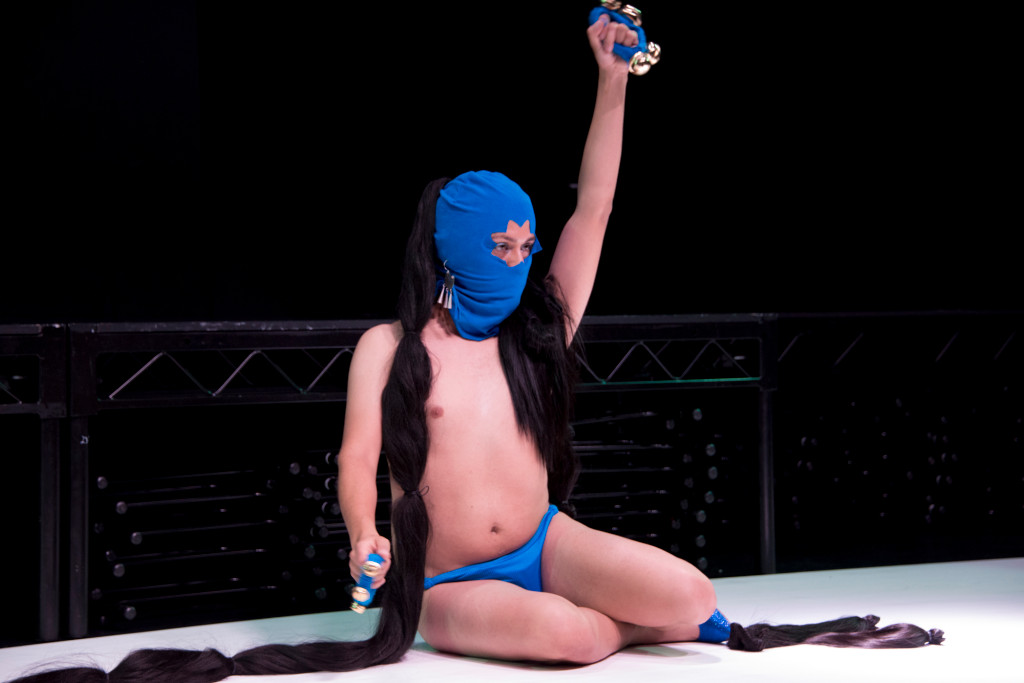[ad_1]
The sounds of a deranged fugue escaped Laura Ortman’s amplified violin as dust from her rosined bow flew into the air. A tenuous melody warbled as she slid her fingers against the instrument’s strings, causing the stereos to screech. What could have been easily identifiable as a prairie song or an Apache tune became unrecognizable. It sounded like nothing most in the audience had ever heard.
Last weekend, Performance Space New York, an alternative space in the East Village, was filled with emotional performances like Ortman’s as part of “Knowledge of Wounds,” a two-day series of performances, readings, and discussions led by Indigenous artists. According to the organizers, artist S.J Norman and academic Joseph Pierce, the program brings together people who identify as queer and Indigenous to build kinship and a collective future.
“I’m usually the token character at events like this,” Joshua Whitehead, an Oji-Cree/Peguis storyteller from Canada, told ARTnews after he performed on Sunday. “We are centering queerness and indigeneity, and that’s groundbreaking.”
“Knowledge of Wounds” developed from a chance meeting between Norman and Pierce at “First Nations Dialogues,” a program at Performance Space last January. (That program’s lead organizer, the choreographer Emily Johnson, was one of this year’s participating artists.) By the spring, the two curators landed on the concept of wounds in response to U.S. President Donald Trump’s inflammatory comments about migrants. “At a time when the aggravated imposition of national borders is producing violent consequences all over the world,” Norman and Pierce wrote in a curatorial statement, “how might we consider these questions within the broader, ongoing history of settler colonialism?”
According to Norman, who is Koori of Wiradjuri descent, such a question is relevant to an art world in which Indigenous people are often tokenized. “The siloing of our Indigenous communities is a deliberate strategy for dissolving our networks of solidarity,” the artist, who identifies as transmasculine, said. “Because if we were able to access the full capacity of our incredible, agile systems of knowledge, we could fuck shit up.”
That sense of tension pervaded “Knowledge of Wounds.” Ortman’s impassioned violin—with its trace references to John Cage and modern music—was one such example. There was also SHATTER/// by the artist Demian DinéYahzi’ and his cousin, the composer Kevin Holden. Described as an “extractive performance,” the pair of relatives, who share Diné heritage, summoned a deafening symphony of electric guitar and confessional poetry. The ear-bleeding pitch of Holden’s guitar, which he gradually smashed to smithereens, left many in the audience plugging their ears, and only then could one just barely distinguish DinéYahzi’’s words from the roar. But that seemed to be the point: hard truths are seldom heard with ease. The performance ended with the smashing of racist knick-knacks and tchotchkes—a destruction of stereotypes that have long pervaded Native American peoples.

Blair LeBlanc
The majority of the weekend’s activities were confessional, soft-spoken, and mindful. Each day of programming began with a group movement session and an opening blessing before a ceremonial fire burning in the Performance Space courtyard. Upstairs, performers and audience members congregated inside A Famine of Hearing (2019), a large-scale installation by Sarah Zapata—a queer artist of Latin American descent whose work is inspired by ancient Indigenous traditions—with a handwoven sea of geometric forms covered in textiles serving as a landscape for viewers to explore.
Though not officially part of “Knowledge of Wounds,” Pierce, who is a citizen of the Cherokee Nation, viewed the Zapata installation as a poignant inclusion: “Our work here is about the culture of reciprocity; it’s about expanding networks of kinship.”
The act of witnessing was important to many participants intent on sharing the weight of violence that governments have historically waged against Indigenous populations. “Knowledge of wounds means knowledge of healing,” said Javier Stell-Frésquez, a dancer who helped lead Sunday’s opening blessing. “We see what’s wrong with society and have the medicine and knowledge needed to help.”
For Lukás Acedaño, an artist of Zapotec heritage from Mexico, the weekend was an opportunity to see himself as part of a wider community intent on fighting against the hegemonic structures of identity. One of the most important living figures of Muxe culture in the Oaxaca region, Acedaño screened a documentary about his work by the journalist Miguel J. Crespo called La utopía de la mariposa (The Utopia of the Butterfly). It’s an arresting look into the performance artist’s career and the disappearance of his brother Bruno, who is among some 40,000 people who have gone missing in Mexico.
Like the organizers of “Knowledge of Wounds,” who aspire to expand their programming internationally, Avedaño hopes that one day queer indigeneity will find an audience large enough that it won’t be considered niche. “There should be no bubble,” he said. “We should not need a safe room where we are specimens looking for each other. This should be a space where we can find each other in freedom, happy and in love as anyone else.”
[ad_2]
Source link

